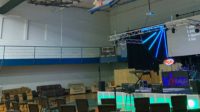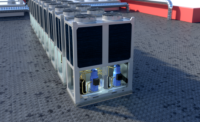
Fabric
duct installation at this North Carolina church has reduced mold and
saved space.
It’s difficult to believe that a routine item such as HVAC ductwork could have as great affect on a church as it has at Riverbluff Church (North Charleston, SC).
Members of the church’s design team all like something different about the fabric duct at the Southern Baptist denominational church’s new $500,000, 5,000-sq-ft secondary auditorium/multi-purpose facility designated as “The Annex.”
For mechanical contractor, James Thomas, president, J&J Heating & Cooling (Goose Creek, SC), fabric duct helped save his client 50% in HVAC ductwork material and installation costs vs. other options. For Robert Gerber, principal at GJS Architects LLC, and project consulting engineers EPIC Engineering Inc. (Wando, SC), the ductwork is all about the appearance, acoustics, and indoor air comfort performance. For the church’s maintenance staff, the fabric will be easier to keep clean than metal duct.
Pastor for Discipleship, Joe Still, adds a different twist. “It definitely presents a much quieter airflow than metal duct with registers, which is an important consideration for a room where it’s important to hear speech,” said Still.
Thomas, who has installed fabric duct by Ductsox Corp. (Dubuque, IA) in past church and gym projects, spent only three hours installing the cable suspension system and an additional half-hour suspending the three 50-ft runs of 14-in.-dia Tuftex, high-throw fabric duct. Manufacturer’s representatives Hoffman & Hoffman (Greensboro, NC) was a liaison between Ductsox and Thomas to ensure the linear array of high-throw ½-in.-diar diffusers in the 18-ft-high TufTex were sized correctly to reach church occupants with a gentle, even airflow without drafts. “A similar sized spiral metal duct system would have taken two men at least two weeks to install,” said Thomas. “The labor savings was substantial, and the material costs of fabric versus metal were less as well.”
HUMIDITY RESISTANCE A PLUS
Thomas also likes the fact fabric duct will not sweat in South Carolina’s humid summers. Spiral metal duct can be specified with double walls and insulation, but the attached registers still sweat and are a source for attracting and harboring mold and mildew. The design team also specified Ductsox’s anti-microbial treatment for the fabric which does not allow bacteria to harbor.“In our main auditorium, moisture accumulates on the registers and drops of water occasionally hit people in the head during the service,” said Thomas.
Additionally, the church maintenance staff won’t ever have to paint the ductwork. Cleaning it will require a half-day of taking it down, commercially laundering it, and putting it back up.
Fabric duct is just one innovation the design team built into the project. A major cost innovation was GJS’s choice of an open architecture ceiling, which saved the project an estimated $20,000 vs. a finished ceiling.
“An open architecture ceiling works well in a contemporary church environment,” said Gerber, whose four-year-old architecture firm specializes in church design such as Seacoast Church (Mt. Pleasant, SC), which was voted one of the ten most influential churches in America by TheChurchReport.com and one of the most innovative and fast-growing by Outreach Magazine.
The design team had considered an expensive BAS, but Aaron Tempel, P.E., principal, EPIC Engineering, lobbied instead for three 7-day programmable thermostats by White-Rodgers - division of Emerson Co. (St. Louis) to control the three high-efficiency 14 SEER, Trane split-system heat pump units that supply the ducts.
The high-efficiency units save operating costs, however Tempel’s idea of using three units with individual programmable thermostats theoretically cut operating costs and properly condition the space during unoccupied hours. Instead of one large unit, which would have to operate regardless of whether the space was occupied or not, Tempel uses one 5-ton unit that conditions the building efficiently during unoccupied hours. At full occupancy, which is only a few times per week, two additional 5-ton units are activated by the thermostats for conditioning to setpoint indoor air comfort levels.
“This is a typical design I use in churches with tight budgets - one unit set slightly lower and two set slightly higher units with individual programmable thermostats,” said Tempel.
Another GJS design feature saved precious square feet. All three HVAC units are installed on a platform mezzanine designed to lend more floor space for storage. The extra height brings the units closer to the 18-ft-high ducts, thus requiring less sheet metal ductwork and installation labor for connection.
Other integral HVAC equipment EPIC Engineering specified on the project are Price Industries louvers for outside air and Greenheck exhaust fans.
Because of the design team’s commitment to value design, Riverbluff Church saved tens of thousands of dollars without sacrificing indoor air comfort. “Since we’ve put it in, everybody has loved the fabric duct’s performance and look,” said Thomas.ES



